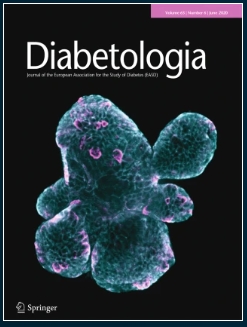SFDT1研究的结果表明,仅低于范围的时间不足以识别1型糖尿病的严重低血糖风险——低血糖意识的关键作用。
IF 10.2
1区 医学
Q1 ENDOCRINOLOGY & METABOLISM
引用次数: 0
摘要
目的/假设尽管有先进的糖尿病技术,1型糖尿病患者仍然经常发生严重的低血糖事件(SHE)。我们研究了时间低于范围(TBR) 3.9 mmol/l (70 mg/dl; TBR70)或3.0 mmol/l (54 mg/dl; TBR54)是否与未来SHE风险相关,以及低血糖意识受损(IAH)是否改变了这种关系。方法:我们分析了法语1型糖尿病学会(SFDT1)研究中使用连续血糖监测的参与者的数据。采用黄金评分(Gold Score)评估IAH(≤2分,无IAH; 3分,不确定;≥4分,IAH)。纳入后12个月自行报告SHE频率。我们使用调整了年龄、性别、社会脆弱性和胰岛素治疗(包括TBR- iah相互作用)的logistic回归模型分析了TBR和SHE之间的关联。我们进行样条分析来探索非线性模式。结果848例患者1年SHE发病率为11.7%(平均±SD年龄41.6±13.3岁,女性53.8%,HbA1c 57.2±10.9 mmol/mol[7.4±1.0%])。≤1%组TBR70的发病率为12.1%,1.1-3.9%组为10.2%,4-6%组为10.6%,> -6%组为14.6%。与TBR70 ≤1%且无IAH的患者相比,只有TBR70 ≤6%和IAH的患者SHE风险明显更高(OR 3.32 [95% CI 1.40, 7.82])。对于TBR54,在分类<1%和≥1%的人群中,SHE发病率分别为11.0%和13.3%。同样,只有TBR54≥1%和IAH的个体有SHE风险增加(OR 2.99 [95% CI 1.46, 5.92])。样条分析显示,在没有IAH的参与者中,TBR70值的SHE风险较低,稳定,仅在有IAH的参与者中呈非线性模式。结论/解释单独TBR对高危SHE没有鉴别作用,但联合TBR和低血糖意识状态可识别TBR70和TBR54的高危人群。临床试验注册。gov NCT04657783。本文章由计算机程序翻译,如有差异,请以英文原文为准。
Time below range alone is insufficient to identify severe hypoglycaemia risk in type 1 diabetes-the critical role of hypoglycaemia awareness: results from the SFDT1 study.
AIMS/HYPOTHESIS
Severe hypoglycaemia events (SHE) remain frequent in people with type 1 diabetes despite advanced diabetes technologies. We examined whether time below range (TBR) 3.9 mmol/l (70 mg/dl; TBR70) or 3.0 mmol/l (54 mg/dl; TBR54) is associated with future SHE risk and whether impaired awareness of hypoglycaemia (IAH) modifies this relationship.
METHODS
We analysed data from participants in the Study of the French-speaking Society of Type 1 Diabetes (SFDT1) who used continuous glucose monitoring. IAH was assessed using the Gold Score (≤2, no IAH; 3, undetermined; ≥4, IAH). SHE frequency was self-reported 12 months after inclusion. We analysed associations between TBR and SHE using logistic regression models adjusted for age, sex, social vulnerability and insulin treatment, including TBR-IAH interactions. We performed spline analyses to explore non-linear patterns.
RESULTS
One-year incidence of SHE was 11.7% among 848 participants (mean ± SD age 41.6 ± 13.3 years; 53.8% female sex, HbA1c 57.2 ± 10.9 mmol/mol [7.4 ± 1.0%]). Incidence by TBR70 was 12.1% for ≤1%, 10.2% for 1.1-3.9%, 10.6% for 4-6%, and 14.6% for >6%. Only those with TBR70 >6% and IAH had a significantly higher SHE risk (OR 3.32 [95% CI 1.40, 7.82]) compared with TBR70 ≤1% and no IAH. For TBR54, SHE incidence was 11.0% and 13.3% for categories <1% and ≥1%, respectively. Similarly, only individuals with TBR54≥1% and IAH had increased SHE risk (OR 2.99 [95% CI 1.46, 5.92]). Spline analysis showed low, stable SHE risk across TBR70 values in participants without IAH, with a non-linear pattern only in those with IAH.
CONCLUSIONS/INTERPRETATION
TBR alone is not discriminative for high-risk SHE but combining TBR with hypoglycaemia awareness status identifies those at the highest risk for both TBR70 and TBR54.
TRIAL REGISTRATION
ClinicalTrials.gov NCT04657783.
求助全文
通过发布文献求助,成功后即可免费获取论文全文。
去求助
来源期刊

Diabetologia
医学-内分泌学与代谢
CiteScore
18.10
自引率
2.40%
发文量
193
审稿时长
1 months
期刊介绍:
Diabetologia, the authoritative journal dedicated to diabetes research, holds high visibility through society membership, libraries, and social media. As the official journal of the European Association for the Study of Diabetes, it is ranked in the top quartile of the 2019 JCR Impact Factors in the Endocrinology & Metabolism category. The journal boasts dedicated and expert editorial teams committed to supporting authors throughout the peer review process.
 求助内容:
求助内容: 应助结果提醒方式:
应助结果提醒方式:


